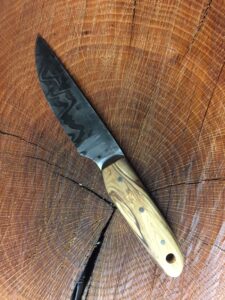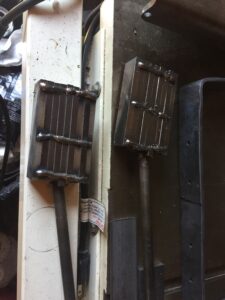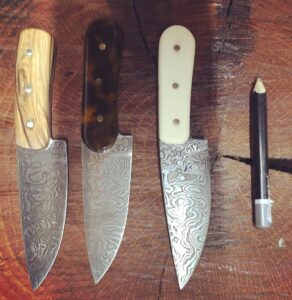 I’ve been working on improving my skills. Making Damascus steel pattern welded style. Various different layers stacked on each other. Taking a flat bar of high carbon 1084 and layer it with a high nickel steel, 15N20, stacking up the bars, usually 1/8 of an inch or so, and at least a few inches long for the starting billet. Some of it comes down to what I can work with easily.
I’ve been working on improving my skills. Making Damascus steel pattern welded style. Various different layers stacked on each other. Taking a flat bar of high carbon 1084 and layer it with a high nickel steel, 15N20, stacking up the bars, usually 1/8 of an inch or so, and at least a few inches long for the starting billet. Some of it comes down to what I can work with easily.
Surfaces have to be clean and joined together by welding the corners to hold all the layers together. Next, the billet is heated, treated with borax (a flux) and put under a press to forge weld the layers together, as one. Billets can be drawn out, making it longer and thinner, cut up and re-stacked with the same process of cleaning, welding and forging.

As the pieces are stacked it multiplies the layers, 10 to start becomes 30 with the piece cut in thirds and stacked again. Creating more layers in the process. With no limit to
layers, and the compounding factor, say starting with 11, they are forge welded and compressed, drawing out the bar of steel, and thickness decreases.
Once that is completed, the bar is cut in 3 pieces, forge welded again, making it 33 layers, again the bar is cut up, forge welded and the count is 99. Again the process is done with the next step producing 297 layers. As the layers are added they become denser and denser. closer and closer together. Any distortions in pressing upsets the layer randomly, which causes the paisley like pattern vs. straight lines in parallel.
